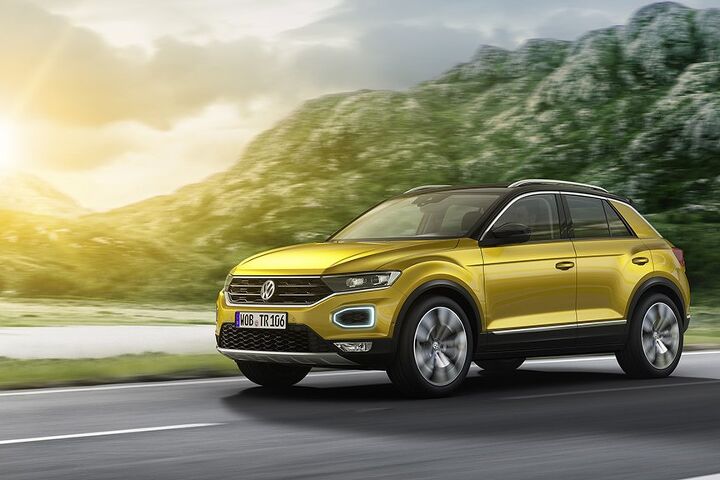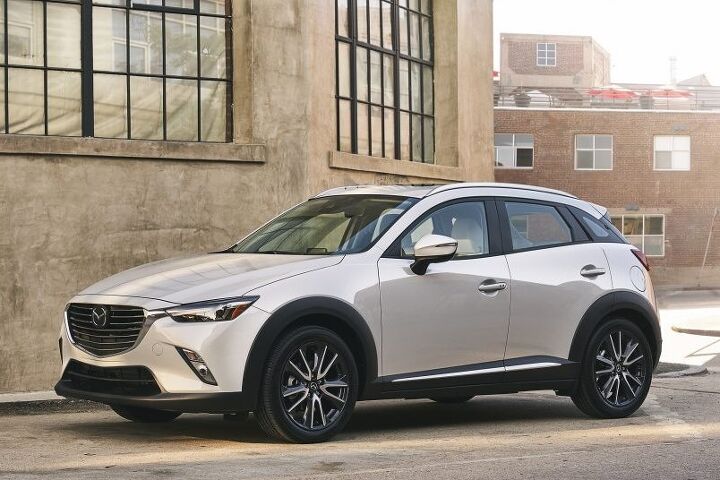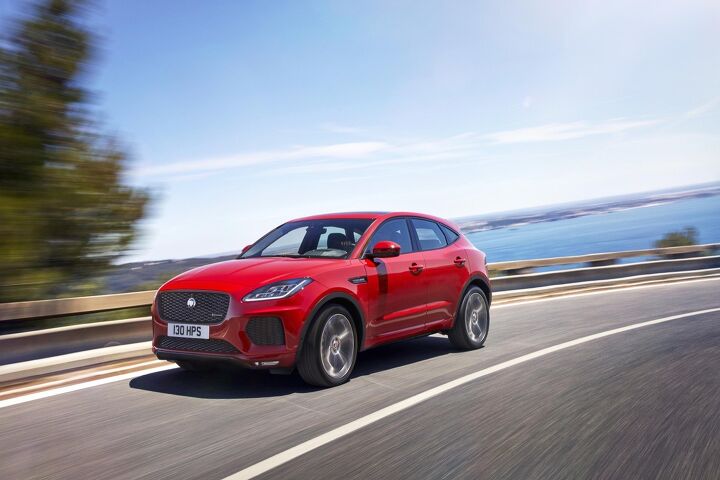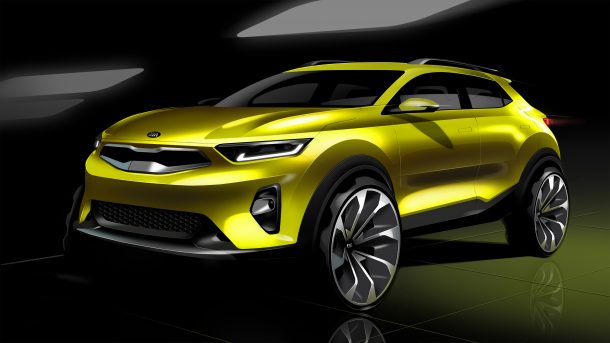#SubcompactCrossovers
Jaguar Drops the Curtain on E-Pace at North American Reveal
Jaguar introduced its newly expanded 2018 model year lineup for North America last week, with the British automaker adding the subcompact E-Pace SUV, XF Sportbrake wagon, and XJR575 flagship sedan to its roster. With these new models, Jaguar hopes to continue the sales momentum that made it the fastest-growing automotive brand in the US market in 2016.
The 2016 model-year addition of the F-Pace SUV and XE sedan led to a doubling of the brand’s annual sales, and its best showing since 2004. For the coming year, Jaguar aims to cover more bases and lure in the buyers it missed.
The 2018 Ford EcoSport Starts at $20,990, But How Much Could You Spend on a Loaded EcoSport?
For the 2018 model year, your local Blue Oval dealer will sell you an India-built Ford EcoSport Titanium AWD, with a handful of options, for $29,960.
Yes, that’s an uncomfortable MSRP for the funny-looking, tippy-toe-styled EcoSport, which Ford likes to pronounce echo-sport as if it’s a particularly athletic Toyota subcompact sedan circa 2003. But the entry point for Ford’s new entry-level crossover is much, much lower. At $20,990 including delivery — a 16-percent discount compared with the Ford Escape S — a 2018 Ford EcoSport sends power from its 1.0-liter turbo triple to the front wheels through a standard six-speed automatic transmission.
No, America Can't Have a Volkswagen T-Roc, But VW Is Tripling Production Before Production Even Begins
America can’t have the Volkswagen T-Roc. Canada can’t have the Volkswagen T-Roc. As far as we know at this point, Australia can’t have the T-Roc even though the segment in which it competes owns a hefty one-tenth of the Australian market.
Volkswagen nevertheless sees huge global potential for the brand’s new subcompact crossover, all the more so since actually unveiling the new model in late August.
The Volkswagen T-Roc’s Portugal assembly plant will therefore not build a modest 70,000 annual units. Though sales aren’t yet underway, Volkswagen board member Jürgen Stackmann says the automaker has already determined it’s necessary to triple annual production, according to CarAdvice.
Sorry, Stonic - Kia's Got All the Small Vehicles It Needs In the U.S.
If you’re an aspiring B-segment crossover owner looking for Korean value and a fresh face, but aren’t exactly enamored with the 2018 Hyundai Kona‘s looks, you’re out of luck. For now, anyways. The Kia Stonic, revealed in Europe earlier this summer, is definitely not making the boat ride to America. Well, probably definitely.
Definitely maybe.
The automaker says it has no current plans to offer the subcompact crossover — which is arguably better looking than the U.S.-bound Kona — to utility-crazed on this side of the ocean. It’s clear Kia isn’t so sure of the extent of Americans’ appetite for non-cavernous vehicles.
Confirmed: Volkswagen Canada Won't Be Offering the T-Roc, Either
Not only is Volkswagen’s recently unveiled T-Roc subcompact crossover destined to avoid U.S. shores, Volkswagen’s Canadian dealers won’t be offering the T-Roc, either.
Revealed last week, we had always assumed the T-Roc was the logical next step for a Volkswagen brand that had suffered long and hard from a limited, delayed, premium SUV strategy in North America.
But it turns out Volkswagen of America will skip the T-Roc, likely in favor of a different small utility vehicle. So we asked Volkswagen Canada whether the T-Roc would arrive for the 2018 model year, the 2019 model year, or never at all.
Volkswagen’s response is the third option. “At least for now,” company spokesperson Thomas Tetzlaff tells TTAC.
Surely small-car-loving Canada — where the Honda Civic has been Canada’s top-selling car for 19 consecutive years and subcompact cars hold 19 percent more market share than they do in the U.S. — wants another subcompact crossover? Nah, not so much. Like Americans, Canadians haven’t fully latched onto the subcompact crossover, either. Not yet.
2018 Mazda CX-3 Is Better, But Until It's Bigger, Better Probably Isn't Good Enough
Accompanied by a modest price increase of $150, Mazda’s first-generation CX-3 undergoes numerous under-the-skin updates for the subcompact crossover’s third model year.
Mazda’s Smart City Brake Support is now standard across all 2018 CX-3s. G-Vectoring Control, a nifty piece of software that sharpens steering response while reducing driver effort, is also standard on every 2018 Mazda CX-3. Mid-grade CX-3 Tourings are now equipped with auto headlights, auto climate control, and rain-sensing wipers.
Thicker glass, more sound deadening, and improved door seals bolster every CX-3’s refinement quotient. Mazda has also altered the suspension tuning of all CX-3s for the 2018 model year. Mazda claims revised bushings, new front lower control arms, recalibrated dampers, and new engine mounts will improve the CX-3’s “already class-leading chassis dynamics.”
Mazda’s probably not wrong. The 2016-2017 CX-3 was an exceptionally pleasing subcompact crossover to drive. And on that particular subject — on-road behavior — we’re apt to trust Mazda when the company says the refreshed model will be even better. But this is just a refresh, and an invisible refresh at that. As a result, the Mazda CX-3 has the same limitations for MY2018 that it had before, the kind of limitations that severely cramp demand.
It’s very small.
Volkswagen T-Roc Is Definitely Not Coming to America Now (and Probably Not Ever)
Volkswagen is perpetually late to the SUV party. That much we knew already. The Volkswagen Touareg came late, and was improperly positioned. The Volkswagen Tiguan was much later, and it too was overpriced and undersized. The Volkswagen Atlas, the brand’s first three-row crossover, only arrived in America this spring.
The Volkswagen T-Roc was clearly not the first guest to arrive, either. The Nissan Juke, Mini Countryman, Subaru Crosstrek, Buick Encore, Chevrolet Trax, Jeep Renegade, Fiat 500X, Honda HR-V, and Mazda CX-3 have been collecting U.S. sales for years. But it’s not as though Volkswagen was the only major automaker late to the party. Ford’s EcoSport still isn’t here, the Hyundai Kona and Kia Stonic were unveiled only recently, and Toyota’s C-HR is a fresh release that lacks an all-wheel-drive option.
But the Volkswagen T-Roc, revealed last week, will be more than just late to the party. In the United States, the Volkswagen T-Roc has returned its invitation by ticking the wrong box. Regret to decline.
Volkswagen of America has confirmed to TTAC that the Volkswagen T-Roc will not come to the United States, probably not ever.
GMC Needs a Subcompact Crossover; Brand Boss Says GMC 'Should Have Been First in the Segment'
Small crossovers are a natural fit for a brand that sells not a single passenger car, but GMC has been sorely lacking in smaller utility vehicles for much of its tenure.
The first-generation GMC Terrain, something of a tweener-sized utility vehicle, didn’t arrive until 2009. For its predecessor, General Motors decided to concentrate attention on its Pontiac brand, which resulted in the oft-forgotten Torrent.
But down another rung on the ladder sits subcompact utility vehicles. GMC brand boss Duncan Aldred says General Motors’ all-light-truck division “should have been first in the segment.” Instead, the Buick Encore and Chevrolet Trax generate 13,000 monthly U.S. sales, thereby controlling America’s subcompact crossover category.
GMC? On the sidelines, waiting for the next generation of GM subcompacts to spawn a crossover for the very brand that should have had one in the first place.
Do It for the Children: Honda and Toyota Sticking With Small Cars for the Sake of Our Children, and Our Childrens' Children
The Dodge Dart is dead. The Ford Fiesta is likely on its last legs in the United States. Ford Focus production is moving to China, off the North American continent where demand for Ford small cars is rapidly declining. General Motors is scaling back production at the Chevrolet Sonic’s Orion Township, Michigan, assembly plant.
That’s the Detroit small car picture, or at least part of it. From Japan’s perspective, however, small cars are entirely worth it, not just because of the sales success enjoyed by the Honda Civic (currently America’s best-selling car through 2017’s first seven months) and Toyota Corolla, but because of the demographic small cars target.
When It Comes to Tardy SUV Launches, at Least Volkswagen Knows It Has a Problem
“I don’t know why we are late.”
– Frank Welsch, head of development for Volkswagen, ahead of T-Roc launch
It’s been less than one week since TTAC’s B&B had its collective say on the subject of Volkswagen’s SUV delays. But in an interview with Autocar, Volkswagen’s head of development, Frank Welsch, certainly isn’t denying the problem.
“I don’t know why we are late,” Welsch says, speaking not only of utility vehicles such as the T-Roc, but Euro-MPVs as well. “With the Touran we were late, the Sharan we were late. I cannot explain why, here we are.”
“I’m happy to have this car now.”
As if stepping out of a rehab program for automakers addicted to ignoring obvious trends, Volkswagen has finally completed the first step: recognizing the problem. The T-Roc will be unveiled this afternoon, August 23, 2017, years after the Nissan Juke, Mini Countryman, Subaru Crosstrek, Buick Encore, Chevrolet Trax, Jeep Renegade, Honda HR-V, and Mazda CX-3 took control of the subcompact crossover segment.
The Subaru Crosstrek Is More Than Just Big Volume for Subaru, It's Good Volume
After the Impreza-based Subaru Outback Sport failed to catch fire with all the ignition of the Legacy-based Subaru Outback, Subaru’s approach differed only slightly when the XV Crosstrek debuted as an upsized rival for vehicles such as the Nissan Juke. Beating the Honda HR-V, Chevrolet Trax, and Jeep Renegade to the punch, the XV Crosstrek produced consistent and significant year-over-year U.S. sales growth.
From the 53,741 sold in 2013, Subaru reported a 32-percent improvement in 2014, a 25-percent gain in 2015, and a further 8-percent uptick to 95,677 in 2016.
Now that Subaru is preparing to launch the second-generation Crosstrek — the XV tag disappeared after MY2015 — it’s becoming increasingly apparent that Subaru isn’t just making hay off the Crosstrek by selling a whole bunch of Impreza-based tall hatchbacks.
Subaru also sells Crosstreks to the right people.
The $39,595 2018 Jaguar E-Pace Takes the Fight to the BMW X1 in January
Not to be confused with the electric Jaguar I-Pace crossover, the 2018 Jaguar E-Pace was unveiled July 13 with a blend of F-Type and F-Pace styling cues.
Set to challenge the BMW X1, Mercedes-Benz GLA, Audi Q3, and Infiniti QX30 when it goes on sale in the United States in January 2018, the Jaguar E-Pace will be marketed with standard all-wheel drive, a nine-speed automatic, and turbocharged 2.0-liter four-cylinder powerplants generating either 246 or 296 horsepower.
Globally, the E-Pace will quickly become Jaguar’s best-selling model. In the United States, Jaguar expects the E-Pace to, at the very least, sell just as often as the larger F-Pace, which has generated 19,575 U.S. sales for the previously struggling Jaguar brand since going on sale in May 2016.
2018 Hyundai Kona: Late But Not Too Late, Little But Not As Little As The Next One
Nearly seven years after the Nissan Juke. Five years after the Buick Encore. Three years after the Jeep Renegade. Two and a half years after the Honda HR-V. Finally, the 2018 Hyundai Kona is set to arrive as the fourth and smallest member of Hyundai’s utility vehicle lineup.
With the silhouette of a Mazda CX-3, the quirky light treatment of a Nissan Juke, and the cladding of a Pontiac Vibe, the Hyundai Kona will arrive in North America in early 2018 with optional all-wheel drive and a new platform that will be shared with the unfortunately named Kia Stonic.
The platform, Hyundai says, “is optimized to permit SUV levels of ground clearance.” Don’t expect more than 6.7 inches, yet in the Kona’s segment, the little Hyundai won’t actually be that low. But it is small. At 164 inches from bumper to bumper, the Hyundai Kona stretches only two inches longer than a Hyundai Accent hatchback and is four inches shorter than the Mazda CX-3.
Yet by 2020, Hyundai intends to strengthen its crossover lineup by positioning below the B-segment Kona an even smaller A-segment utility vehicle. Like a sidecar for your Santa Fe.
2018 Toyota C-HR Review - Dividing Opinion Doesn't Get Any Easier Than This
Forget, if only for the next few minutes, the way it looks. You may hate it, you may love it. But don’t let your interpretation of the 2018 Toyota C-HR’s exterior angles cloud your judgement.
While you’re at it, set aside class designations, as well. Whether you, like me, consider the 2018 Toyota C-HR to be unqualified for “crossover” status because it’s missing all-wheel-drive availability, the C-HR is still positioned as a rival for front-wheel-drive HR-Vs, Renegades, Encores, and CX-3s, among others.
The Toyota C-HR was initially intended to form part of the Scion lineup in North America, but with that brand’s demise, Toyota wisely moved the C-HR into its own lineup. Slotted below the Toyota RAV4 with dimensions that all but mirror the old Toyota Matrix, the 2018 Toyota C-HR is a $23,495-25,435 hatchback that’s garnered more attention during its stay with me than any vehicle I’ve ever tested.
To my surprise, almost all of that attention was positive. But is the Toyota C-HR worthy of such attention?
Kia Stonic: C'mon Kids, Dig This Rad Crossover
Few automakers can afford to sit on the sidelines while rivals do battle in the growing subcompact crossover segment, and Kia sure isn’t one of them. Back in January, a trademark filing revealed Kia was developing a vehicle bearing an odd name — Stonic — which many rightly guessed would become the brand’s newest crossover. Well, that mystery vehicle is no longer a mystery.
The automaker has released concept sketches of its upcoming subcompact crossover, a high-beltline, low-roof runabout with wheels tailor-made for pelting stones off its sickly off-gold paint.






























Recent Comments